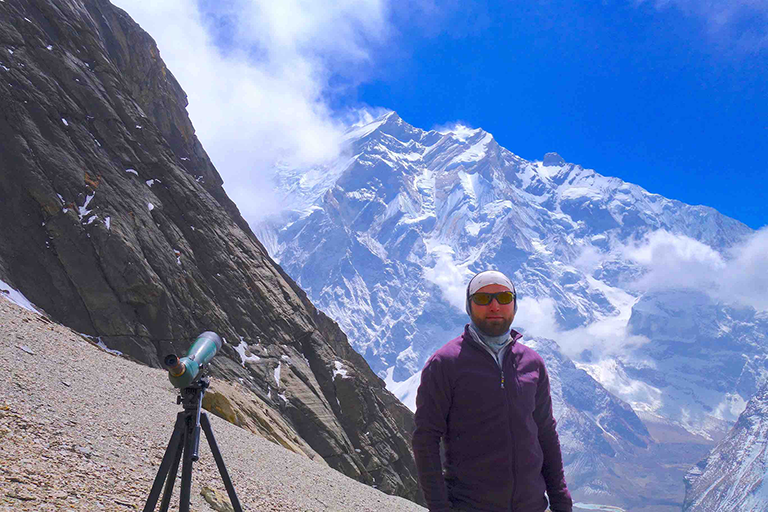Starlit Push
Once fully suited, harnessed and packed, we stepped out in to the frigid night air. In the five minutes I spent standing outside the tent with the conductive steel spikes of my crampons stuck in to the snow, I could start to feel my toes numb, even with chemical toe warmers clumsily stuck to my socks.
When Pema Sherpa motioned for us to take off as a pair, we rocketed up towards the headlamps bobbing slowly up the hill ahead of us and I started to feel my extremities again. Before moonrise, the only reference of movement and progress is the twinkling of those headlamps above and below you and the dim, static stars above. They are comforting though. As long as there are stars, there aren’t clouds and high winds pushing snow around the mountain or into you. You feel this delicate sense of comfort in the quiet, soft warmth of your down suit; you feel the biting cold of the outside air on your face and gaze at the long trail of steam you exhale into the cold, thin air. I peeled back the gauntlet on my mittens every 20 minutes or so to gaze at the tiny route line on my Suunto Ambit 3 GPS watch. The dim backlight seems blinding in the dark night. Part of modern 8000m peak ascent is this night start but without moonlight, people are left to follow contours on the mountain that they know by daylight. This has led expeditions to lose their way at night only to have to make up lost ground or retreat when the sun reveals their location.
Lakpa Sherpa and I sat down before the expedition with mapping software and drew an approximate route I could view from my Ambit 3 without carrying a clumsy handheld device and exposing skin. It worked brilliantly. It drops digital breadcrumbs along the way so if you encounter whiteout conditions, you can return—even in blinding conditions—to within a meter of wherever you started. The dozen people who died in the 1996 Everest blizzard didn’t have this kind of technology.
In fact they didn’t have a lot of what high-altitude mountaineers enjoy today, and in fact depend on to reduce risk. The electronics I had ranged from the vital—like my GPS watch—to the necessary (solar panels, DeLorme/Garmin satellite gear, batteries, Nexus smart phone) to really-nice-to-have: Chromebook (research, watch movies, send and receive email), Ricoh Theta 360 degree camera, pico projector (project movies). At altitude in brutal conditions, they all functioned flawlessly. I used the Bluetooth-enabled chest strap with the Ambit 3 to train on short, pre-summiting hikes to monitor my heart rate and progress. I marveled at how I grew less and less fatigued and stronger with each passing day. Data from devices like this can be used by doctors on the mountain for both routine and emergency medical reasons, and it’s making a huge difference on the mountains.
Technology’s Impact
Still, I’ve been asked more than once, does all this technology make climbing too easy, take the challenge out of it? After all, didn’t Messner and Habeler summit Everest without oxygen?
By making it safer we can take more risks, yes. But I don’t think I take bigger risks. I never want to depend completely on the technology, but it makes mountaineering safer.
Two weeks later, on May 16, I sat at basecamp in the shadow of Dhaulagiri. The day before we had attempted a summit push there, but I pushed too hard in the heat and stalled out at 5700m. I could blame losing half of my gear, blisters, significant muscle and weight loss, a persistent cough that rattled my ribs and back and that 80% of the fixed lines from BC to C1 were swept away by avalanche. But those things are part of every summit push on an 8000m peak.
The reason I turned around was simple: I had exhausted my willingness to suffer and still be able to make good decisions while I was on Annapurna. I’d hit my personal tolerance for risk at 5700m on Dhaulagiri. I’d never attempted back-to-back 8000m peaks, but since Dhaulagiri was right across the valley from Annapurna, why not try?
Technology has advanced mountaineering in astonishing ways, but it can’t do much to prolong the tolerance for suffering. Of the 21 people who made a summit push on the 15th, all of them turned back and made it down to base camp. Alive.
(Matt Du Puy, who received his bachelor’s in engineering from California Polytechnic State University San Luis Obispo, is a principal software engineer at ARM in San Diego, Calif. He is believed to be the only American to summit Everest, K2 and Annapurna on his first attempt.)















